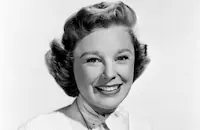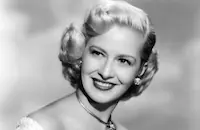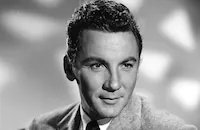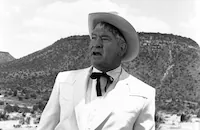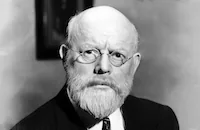High Barbaree was the second of five collaborations for Johnson and Allyson, both contract actors with the MGM stock company; together the two were considered the embodiment of the wholesome couple of the post-WWII era. They first appeared in Two Girls and a Sailor in 1944, followed by High Barbaree, then The Bride Goes Wild (1948), Too Young to Kiss (1951), and finally in Remains to be Seen (1953). Although in real life the two were just friends, MGM's publicity department worked overtime to convey a different impression. The studio arranged official dates and public events for the two to attend, even providing limousines for important occasions. The two were so inextricably linked that joint Van Johnson-June Allyson fan clubs were created.
The truth is Johnson and Allyson did have a lot in common. In addition to being stock actors, they both got their break as theatrical understudies. When Betty Hutton was stricken with measles during a run of Panama Hattie, Allyson filled in with what would be her first big break. Director George Abbott cast her in his next musical, Best Foot Forward, and Allyson made her screen debut in the 1943 film version. Curiously enough, Abbott would also cast Johnson as the understudy to the three male leads in Too Many Girls. When one left to get married, Johnson stepped into his role; he would later be cast as a bit player in the 1940 film version.
Allyson's trademark timbre was the key to her contract with MGM. Producer Joe Pasternak convinced studio head Louis B. Mayer to sign her on because of her distinctive voice. In her autobiography, Allyson writes that Pasternak pleaded, "Please look at this screen test and do just two things. Look at her eyes and listen to her voice. Don't pay any attention to anything else about her. Those are distractions we can iron out." The huskiness of her voice was actually due to medical reasons, specifically, chronic bronchitis and enlarged vocal chords. Johnson playfully referred to her voice as "million dollar laryngitis".
Johnson experienced medical problems of his own during the filming of his breakthrough movie, A Guy Named Joe (1943), also starring Spencer Tracy, a long-time idol of Johnson. On his way to a screening of the latest Tracy flick, The Keeper of the Flame (1942), Johnson's convertible was badly wrecked in an accident. The actor's injuries were so severe that a metal plate was implanted in his head. MGM wanted to replace him with another actor, but Tracy insisted on halting the production until Johnson had recovered, a decision that would propel Van to stardom upon the film's release.
Besides Johnson and Allyson, High Barbaree also features some solid performances from the supporting cast, particularly Thomas Mitchell and Henry Hull. Mitchell is considered one of the most impressive character actors in American film; his roles include Scarlett O'Hara's father in Gone with the Wind (1939) and Uncle Billy from It's a Wonderful Life (1946). His performance as the alcoholic doctor in Stagecoach (1939) earned him a Best Supporting Actor Oscar. As for Hull, he initially established his reputation as a leading man during the silent era, but is probably best known to horror fans for Werewolf of London (1935), his first starring role in talking pictures. His greatest accomplishment, however, was his performance as Jeeter Lester in the stage version of Tobacco Road.
Producer: Everett Riskin
Director: Jack Conway
Screenplay: Anne Morrison Chapin, Whitfield Cook, James Norman Hall (novel), Cyril Hume, Charles Nordhoff (novel)
Cinematography: Sidney Wagner
Costume Design: Irene
Film Editing: Conrad A. Nervig
Original Music: Herbert Stothart
Principal Cast: Van Johnson (Alec Brooke), June Allyson (Nancy Frazer), Thomas Mitchell (Capt. Thad Vail), Marilyn Maxwell (Diana Case), Cameron Mitchell (Lt. Joe Moore).
BW-91. Closed captioning.
By Eleanor Quin






